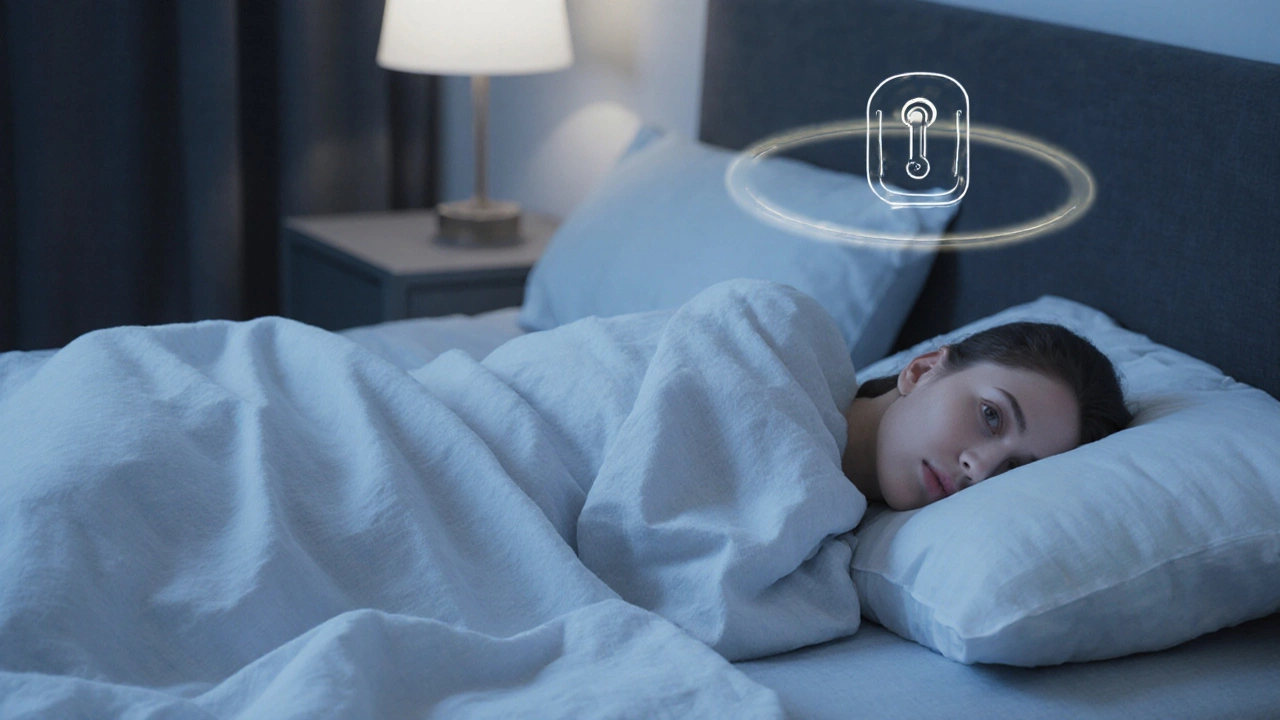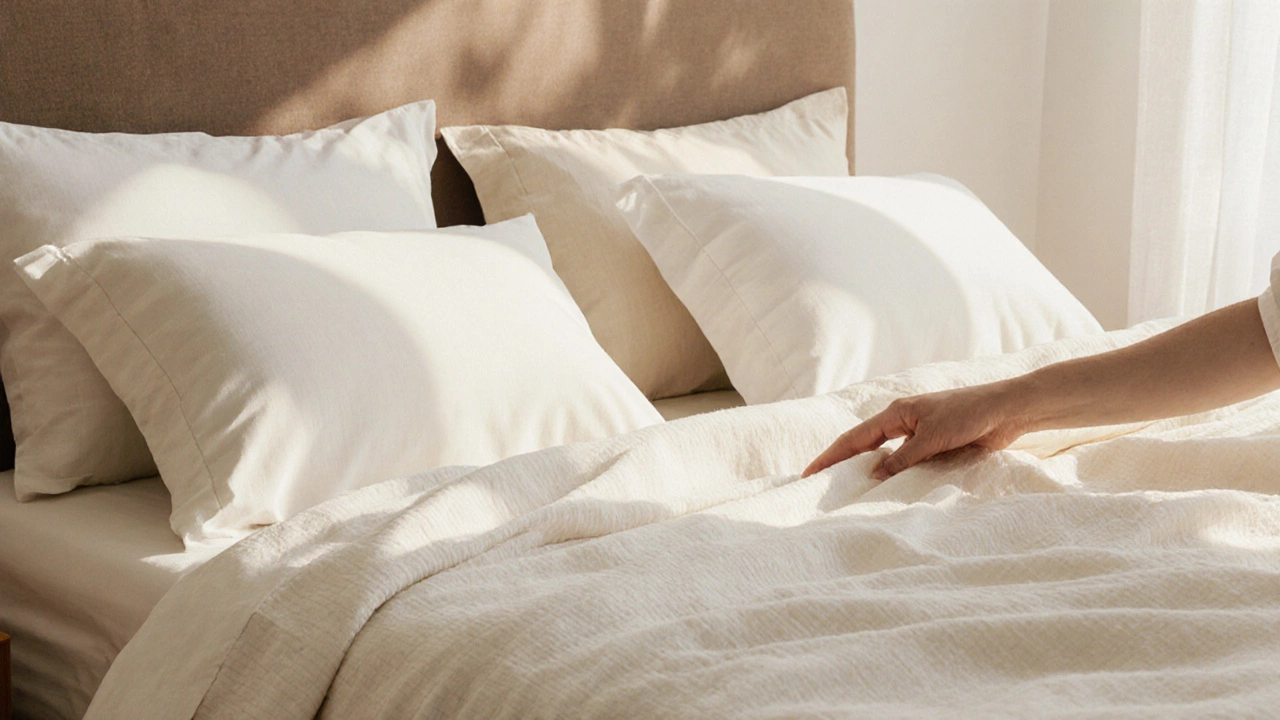Bedding Selector Tool
Find Your Perfect Bedding
Answer a few questions to get personalized recommendations based on your sleep needs.
Key Takeaways
- Three main families of bedding-natural fibers, synthetic blends, and specialty fabrics-cover every budget and climate.
- Cotton (especially Egyptian or Pima) shines for softness and durability; linen excels in hot climates; bamboo offers eco‑friendly hypoallergenic comfort.
- Thread count matters, but fiber quality and weave type matter more for long‑term feel.
- Invest in a quality set for the master bedroom, then match secondary rooms with cost‑effective options like microfiber.
- Proper care (wash temperature, drying method) extends sheet life by up to 30%.
When you ask yourself what is the best type of bedding, the answer depends on how you sleep, where you live, and how much you want to spend. Below we break down the most common bedding materials, compare their key attributes, and give a step‑by‑step guide to pick the right set for your bedroom.
Bedding is a collection of textiles that cover a mattress, including sheets, pillowcases, and sometimes fitted covers. The right bedding can regulate temperature, reduce skin irritation, and even improve sleep quality.
Understanding the Main Material Families
Cotton is a natural fiber harvested from the seed pods of the cotton plant. It’s the most widely used bedding material because it balances breathability, softness, and affordability. High‑quality cotton-like Egyptian, Pima, or Supima-features longer staple fibers that produce smoother yarns and less pilling.
Linen is a fabric made from the flax plant’s stalk fibers. It feels crisp when dry and becomes softer with each wash, making it perfect for hot sleepers and dry climates.
Bamboo is a regenerated cellulose fiber derived from bamboo pulp. It’s celebrated for its silky texture, natural antimicrobial properties, and low environmental impact.
Silk is a protein fiber produced by silkworms. It offers a luxurious sheen and excellent temperature regulation, but it requires delicate care and higher cost.
Tencel is a brand name for lyocell, a semi‑synthetic fiber made from sustainably harvested wood pulp. It mimics the breathability of cotton while feeling smoother than most synthetics.
Microfiber is a synthetic polyester blend woven extremely tightly to create a soft, wrinkle‑free surface. It’s budget‑friendly and dries fast, yet it can trap heat for side sleepers.
Comparison Table: Which Material Beats Which?
| Material | Typical Thread Count | Breathability | Feel | Price (per sqft) | Best For |
|---|---|---|---|---|---|
| Cotton (Egyptian) | 200‑400 | High | Soft, buttery | $$ | All‑season, durable |
| Linen | 80‑150 | Very High | Cool, slightly textured | $$$ | Hot climates, eco‑conscious |
| Bamboo | 300‑600 | High | Silky, smooth | $$ | Allergies, moisture‑wicking |
| Silk | 150‑300 | Medium | Luxurious, cool | $$$$ | Luxury, skin‑care |
| Tencel | 200‑400 | High | Soft, drapey | $$ | Sustainable, sensitive skin |
| Microfiber | 200‑500 | Low‑Medium | Smooth, warm | $ | Budget, quick‑dry |

How to Pick the Right Bedding for Your Situation
- Assess your climate. If you live in a humid summer, linen or bamboo will keep you cooler. In colder months, a higher‑thread‑count cotton or a brushed microfiber set adds warmth.
- Identify skin sensitivities. Look for hypoallergenic labels-bamboo and Tencel naturally resist dust mites, while regular cotton can be treated with chemicals that irritate.
- Set a budget. For a main bedroom, invest in a 300‑thread‑count Egyptian cotton set ($$‑$$$). For guest rooms, a microfiber or Tencel blend gives comfort without breaking the bank.
- Choose the weave. Percale gives a crisp, cool feel; sateen feels smoother and slightly warmer. The weave interacts with the fiber: percale cotton feels like linen, while sateen works well with bamboo.
- Check care instructions. Silk demands hand‑wash or gentle cycle, while cotton, linen, and microfiber survive machine wash. Mis‑caring can shorten a sheet’s life by 30%.
Maintenance Tips That Extend Sheet Life
- Wash in cold water for cotton, linen, and bamboo to preserve fiber length.
- Avoid fabric softeners; they coat natural fibers and reduce breathability.
- Dry on low heat or line‑dry; high heat can cause shrinkage, especially in cotton.
- Store in a breathable cotton bag; avoid plastic boxes that trap moisture.
- Rotate sheets every 2‑3 months to evenly distribute wear.
Common Myths Debunked
Myth 1: Higher thread count always means better quality. After about 400, the count reflects thinner yarns rather than real softness. A 200‑thread-count Egyptian cotton often feels richer than a 600‑thread-count polyester blend.
Myth 2: All cotton is the same. Egyptian and Pima cotton have longer staples, which create smoother yarns. Regular upland cotton can feel coarse and pill faster.
Myth 3: Silk is too hot for summer. Silk actually releases heat quickly, keeping you cool in warm weather while staying warm at night.

Quick Decision Tree
Use this simple flow to narrow your choice:
- Do you have allergies? → Bamboo or Tencel.
- Do you live in a hot, humid area? → Linen or Bamboo.
- Is luxury a priority over price? → Silk or high‑end Egyptian cotton.
- Need easy care and low cost? → Microfiber or cotton‑poly blend.
Where to Buy: Trusted Retail Channels (2025)
In 2025, most reputable brands sell directly via their websites and partner with major department stores. Look for certifications such as Oeko‑Tex Standard 100 (chemical‑free) and GOTS (organic cotton). Recommended retailers include:
- Brooklinen - strong range of percale and sateen cotton.
- Parachute - offers linen and responsibly sourced bamboo.
- Sleep Number - sells Tencel sheets with clear sustainability reports.
- Target - budget-friendly microfiber options with good durability.
Frequently Asked Questions
Which bedding material is best for hot sleepers?
Linen and bamboo excel because their fibers are highly breathable and wick moisture away from the skin. A percale cotton set is a close second if you prefer a softer feel.
Can I mix different materials in one bedroom?
Absolutely. Pair a high‑quality cotton set on your main bed for durability, and use linen or bamboo sheets in a guest room where seasonal temperature swings are common.
How often should I replace my sheets?
With proper care, cotton or linen sheets last 5‑7years. Microfiber may wear out sooner (3‑4years) due to pilling. Replace once the fabric feels thin, develops permanent pills, or loses its moisture‑wicking ability.
Is bamboo truly eco‑friendly?
Bamboo grows fast and requires little pesticide use, but the manufacturing process can involve harsh chemicals. Look for "Closed‑Loop" or "Oeko‑Tex" certified bamboo fabrics to ensure a greener product.
Do higher thread counts make sheets hotter?
Not necessarily. Thread count influences fabric density, but the fiber type and weave are far more influential. A 300‑thread‑count linen set feels cooler than a 600‑thread‑count polyester blend.
Choosing the best type of bedding isn’t about picking a single “winner.” It’s about matching material properties to your sleep habits, climate, and budget. By understanding the strengths of cotton, linen, bamboo, silk, Tencel, and microfiber, you can build a sleep environment that feels tailor‑made-and that’ll keep you rested night after night.

